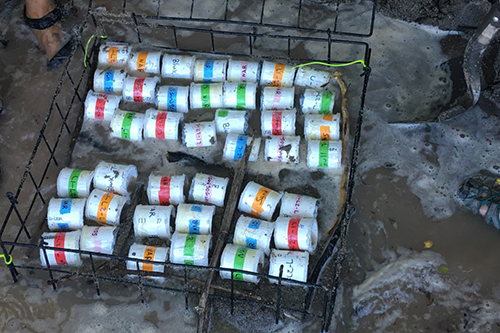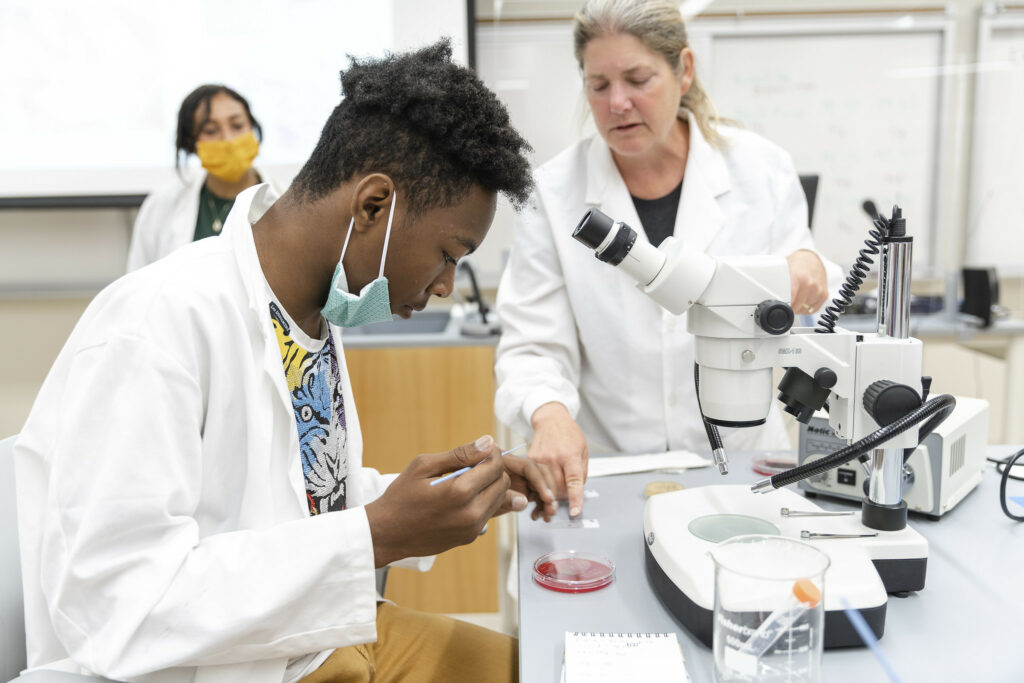Ah, a summer day at the beach: cool water, warm sand and a beverage at hand. Wisconsin’s 180 public beaches are one of the state’s most-valued assets. They provide recreational opportunities, economic benefits for coastal communities and enhance the quality of life for residents.
Keeping those beaches safe for people to use is a continuing process. Beach managers use levels of Escherichia coli (E. coli), a bacterium from fecal pollution in water to know when to keep beaches open or closed. It’s far from a perfect indicator, however. E. coli can come from many sources, not all of it harmful to humans, and it can persist in the environment sometimes for weeks after it was introduced. In fact, sand can contain more E. coli than water. This can make a beach manager’s job complicated.

Microcosms containing E. coli samples were buried in sand for six weeks at several beaches in a related project by McLellan. Image credit: Natalie Rumball
Sea Grant-funded researchers Sandra McLellan and Gyaneshwar Prasad, both with the University of Wisconsin-Milwaukee, are building on previous research to find ways to decomplicate beach managers’ lives by determining what factors could limit long-term survival of E. coli on beaches.
McLellan, a professor in the School of Freshwater Sciences, explained the pros and cons of E. coli as an indicator.
“It’s a great indicator because it’s so easy for people to culture in the lab. It’s easy to count. Where it’s not a good indicator is it really doesn’t tell you anything about the source of what’s there. You don’t know where to direct your management strategies. Should I be chasing away the birds or should I be looking for a leaking sewage pipe nearby? And then to top it off, the other downside is the E. coli survives outside of a host. There’s prolonged survival in the sand and maybe even growth if enough nutrients are available,” McLellan said.
Once outside a human or animal gut, E. coli usually only lives a couple of days. But under certain circumstances, it can live for weeks or even indefinitely in sand.
With graduate student Sophia Ward’s help, McLellan and Prasad are studying sand and water at six Lake Michigan beaches: two in Kenosha County, two in Manitowoc County and two in Milwaukee County. McLellan thinks this array of beaches will provide good representation of what goes on around the Lake Michigan shoreline.

Sandra McLellan interacts with high school students who are studying E. coli in a program she ran in partnership with the Sixteenth Street Clinic in Milwaukee in 2021. Image credit: Wisconsin Sea Grant
They are also testing for levels of nutrients such as carbon, nitrogen, phosphorus and iron. In addition, they are conducting laboratory experiments to “starve” long-lived E. coli of these nutrients to see what drives their survival.
For the lab experiments, E. coli is mixed with sand and packed into small microcosms (miniature environments). McLellan describes them as four-inch diameter PVC pipes cut into four-inch sections. “We bury them in a bed of sand and keep them nice and moist. This helps us mimic what happens at the beach. The water can pass through, but the E. coli can’t escape from those little microcosms.”
The E. coli contain an extra piece of DNA that has a green fluorescent protein engineered in such a way that when the cell is starved, it lights up. The researchers then feed them with water containing varying amounts carbon, nitrogen, phosphorus and iron. They remove the microcosms periodically and count the E. coli to see how many have survived and see if any display the fluorescent-green markers of starvation.
From preliminary experiments, McLellan suspects carbon might be the most important factor that allows E. coli to persist. In beach environments, carbon is often provided by decaying plant life, especially leaves and the nuisance algae, Cladophora.
Once this limiting factor is confirmed, McLellan and her team will develop a scorecard for the potential of long-term E. coli reservoirs for each beach. “By scoring how easily or how much E. coli is growing in the sand at these beaches, it can help beach managers direct their attention to what might be some probable sources at their beaches,” McLellan said. They are also taking nutrient levels into account.
“The scorecard is developing. I think once we understand the dynamic range of what these beaches look like, then we’ll have a better idea of what the scorecard will actually look like,” she added. The information will also be useful to the Wisconsin Department of Natural Resources, which heads the Wisconsin beach monitoring program.





